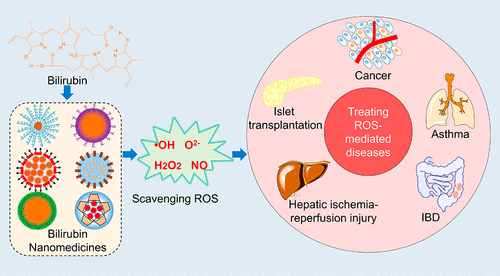当前位置:
X-MOL 学术
›
Mol. Pharmaceutics
›
论文详情
Our official English website, www.x-mol.net, welcomes your feedback! (Note: you will need to create a separate account there.)
Bilirubin Nanomedicines for the Treatment of Reactive Oxygen Species (ROS)-Mediated Diseases.
Molecular Pharmaceutics ( IF 4.9 ) Pub Date : 2020-05-20 , DOI: 10.1021/acs.molpharmaceut.0c00337 Zhejie Chen 1 , Chi Teng Vong 1 , Caifang Gao 1 , Shiyun Chen 1 , Xu Wu 2 , Shengpeng Wang 1 , Yitao Wang 1
Molecular Pharmaceutics ( IF 4.9 ) Pub Date : 2020-05-20 , DOI: 10.1021/acs.molpharmaceut.0c00337 Zhejie Chen 1 , Chi Teng Vong 1 , Caifang Gao 1 , Shiyun Chen 1 , Xu Wu 2 , Shengpeng Wang 1 , Yitao Wang 1
Affiliation

|
Reactive oxygen species (ROS) are chemically reactive species that are produced in cellular aerobic metabolism. They mainly include superoxide anion, hydrogen peroxide, hydroxyl radicals, singlet oxygen, ozone, and nitric oxide and are implicated in many physiological and pathological processes. Bilirubin, a cardinal pigment in the bile, has been increasingly investigated to treat cancer, diabetes, ischemia–reperfusion injury, asthma, and inflammatory bowel diseases (IBD). Indeed, bilirubin has been shown to eliminate ROS production, so it is now considered as a promising therapeutic agent for ROS-mediated diseases and can be used for the development of antioxidative nanomedicines. This review summarizes the current knowledge of the physiological mechanisms of ROS production and its role in pathological changes and focuses on discussing the antioxidative effects of bilirubin and its application in the experimental studies of nanomedicines. Previous studies have shown that bilirubin was mainly used as a responsive molecule in the microenvironment of ROS overproduction in neoplastic tissues for the development of anticancer nanodrugs; however, it could also exert powerful ROS scavenging activity in chronic inflammation and ischemia–reperfusion injury. Therefore, bilirubin, as an inartificial ROS scavenger, is expected to be used for the development of nanomedicines against more diseases due to the universality of ROS involvement in human pathological conditions.
中文翻译:

胆红素纳米药物用于治疗活性氧(ROS)介导的疾病。
活性氧(ROS)是在细胞有氧代谢中产生的化学反应性物质。它们主要包括超氧阴离子,过氧化氢,羟基自由基,单重态氧,臭氧和一氧化氮,并涉及许多生理和病理过程。胆红素是胆汁中的主要色素,已被越来越多地研究用于治疗癌症,糖尿病,缺血再灌注损伤,哮喘和炎症性肠病(IBD)。确实,胆红素已被证明可以消除ROS的产生,因此现在被认为是ROS介导的疾病的有前途的治疗剂,可用于开发抗氧化的纳米药物。这篇综述总结了目前对ROS产生的生理机制及其在病理变化中的作用的认识,并着重讨论了胆红素的抗氧化作用及其在纳米药物实验研究中的应用。以前的研究表明,胆红素主要被用作肿瘤组织中ROS过度产生的微环境中的反应性分子,用于开发抗癌纳米药物。但是,它也可以在慢性炎症和缺血再灌注损伤中发挥强大的ROS清除活性。因此,由于ROS参与人的病理状况的普遍性,胆红素作为一种非人工的ROS清除剂,有望用于开发针对更多疾病的纳米药物。
更新日期:2020-07-06
中文翻译:

胆红素纳米药物用于治疗活性氧(ROS)介导的疾病。
活性氧(ROS)是在细胞有氧代谢中产生的化学反应性物质。它们主要包括超氧阴离子,过氧化氢,羟基自由基,单重态氧,臭氧和一氧化氮,并涉及许多生理和病理过程。胆红素是胆汁中的主要色素,已被越来越多地研究用于治疗癌症,糖尿病,缺血再灌注损伤,哮喘和炎症性肠病(IBD)。确实,胆红素已被证明可以消除ROS的产生,因此现在被认为是ROS介导的疾病的有前途的治疗剂,可用于开发抗氧化的纳米药物。这篇综述总结了目前对ROS产生的生理机制及其在病理变化中的作用的认识,并着重讨论了胆红素的抗氧化作用及其在纳米药物实验研究中的应用。以前的研究表明,胆红素主要被用作肿瘤组织中ROS过度产生的微环境中的反应性分子,用于开发抗癌纳米药物。但是,它也可以在慢性炎症和缺血再灌注损伤中发挥强大的ROS清除活性。因此,由于ROS参与人的病理状况的普遍性,胆红素作为一种非人工的ROS清除剂,有望用于开发针对更多疾病的纳米药物。


























 京公网安备 11010802027423号
京公网安备 11010802027423号